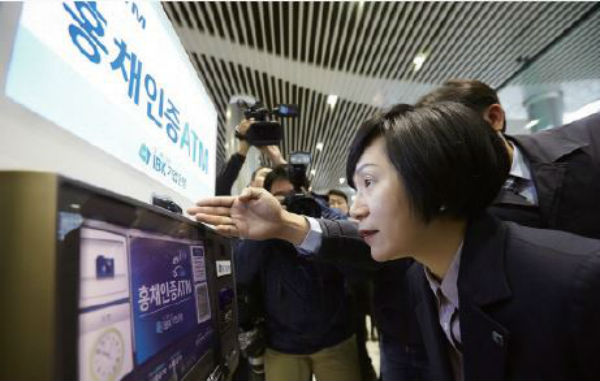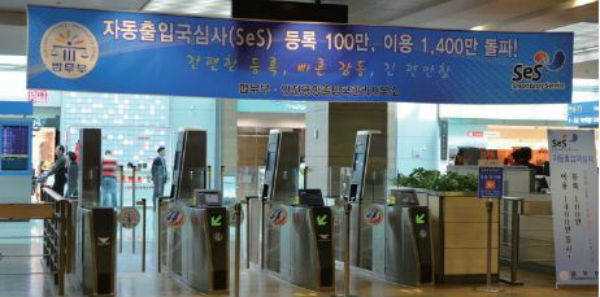There are many things to consider when it comes to choosing a password. A good password should be complicated enough not to be compromised. At the same time, it should be easy enough to remember. In addition, one that overlaps with others’ passwords would not do for some types of passwords. It is indeed tiresome to find the right combination of numbers and letters or patterns that qualify for these conditions. A new type of password, however, can get rid of these troubles. Readers who use iPhones or iPads may already be using this password: fingerprints! Fingerprints have complex and unique designs for each individual and do not require extra attention to carry around. Although fingerprints are the most common example of biometrics, it is only the tip of the iceberg. In this article, the Sungkyun Times (SKT) introduces biometric technology, which is truly becoming a reality.
Biometrics: Complex but Familiar
What is Biometrics?
The Merriam-Webster Dictionary defines biometrics as “the measurement and analysis of unique physical or behavioral characteristics especially as a means of verifying personal identity.” The biometric system goes through the following steps of authentication. First, it transforms the authentication form, such as a fingerprint, into digital data. Then, it extracts distinctive characteristics of the input and stores it in the system. When the sensor receives a new input, the system compares and confirms whether the new input matches with the data of the original.
Authentication Types
Fingerprint recognition is the most commonly used among various authentication types. It has providedcrucial assistance in criminal investigation for more than a century. It is also familiar to the public because starting with the iPhone 5s, Apple has loaded the iPhone series with touch pads that utilize fingerprint recognition for unlocking. Fingerprints are a reliable tool for such usage, as only 2 percent of fingerprints of entire world population are deemed unsuitable.
An iris scan is an authentication type that gives the impression of being detached from reality. However, high quality information that the iris can deliver is attracting much attention. Individual characteristics from which information can be extracted are distributed in the iris in high density. The small size is another advantage. Unlike fingerprint and facial recognition, there is a low possibility of information partially leaking out. If iris scans can overcome the unpleasantness that users feel during the scan, it could surely become an appealing option for authentication.
Recently, the potentials of vein recognition have been in the spotlight. The database compares the newly- scanned vein patterns and originally stored ones. Although the basic principle is the same for all types, a more complicated process is performed for vein recognition. When a person’s hand is put on the scanner, a harmless infrared light is projected onto the input. While the hemoglobin in the vein absorbs the light, other parts let it penetrate. This contrast creates the image of the vein pattern. Vein recognition has been appreciated because it possesses the advantages of both fingerprint recognition and iris scanning. As it runs underneath the skin, it is hard to fake or manipulate vein patterns. Another major advantage is that in order to capture the veins, hands must be attached to living bodies. In other words, those of the dead or severed and stolen ones cannot be used. Despite these advantages, it has yet to come into wide use because the size of the hand scanner is not portable or small.
Facial recognition locates eyes, nose, mouth, and the face line, and measures the space between those features. Along with fingerprint recognition, this authentication type has also been widely used to identify criminals. The advantage it has over the other three types is that it does not require direct contact. Facial recognition, however, is particularly affected by many variables. For example, accessories such as glasses and wigs or external factors such as the lighting, aging, plastic surgery, and posture all become obstacles to facial recognition.
How Far Has Biometrics Come?
Rising Demand
Biometrics arose as a reliable and secure password with the rise of FinTech, the industry which combines finance and technology. The growth of wearable devices such as smartwatches contributed to the trend as well. Biometrics is a core technology in wearable devices. For example, microchips inside smartwatches measure and analyze a user’s health condition in order to provide them with proper health services. Especially in Korea, the finance industry views biometrics as an alternative to certificates for internet banking.
Increasing Market Scale
According to a report by the Korea Information Security Industry Association, the domestic biometrics market in 2014 was 186 billion. This figure is expected to double to 414 billion in 2018. The sales growth for the iris scan system increases more than 94 percent every year. The fingerprint recognition system, which sells the most, shows a steady growth of 10.8 percent. It seems that the government also takes interest in biometrics, as it was selected as one of the top technology trends that will lead digital government this year. Biometrics is showing its strength in the global market as well. The sales of biometrics on mobile devices have increased by 66 percent since 2014. This tremendous increase will amount to $34 billion in 2020. In 2020, biometrics will be applied to 4.8 billion cell phones. Moreover, it is expected that there will be over five billion downloads of mobile applications related to biometrics.
Biometrics in Real Life
The ban of the law which required certain certificates for online banking fueled the introduction of biometrics in the Korean finance industry. Shinhan Bank unveiled an unmanned bank in December 2015, in which bank goers can verify themselves with vascular patterns instead of plastic cards or bankbooks. This bank enables them to do 90 percent of the individual banking business without the help of employees. Lotte Card Company is also preparing to apply a vein recognition system in March 2016. The Industrial Bank of Korea and Woori Bank, on the other hand, ambitiously introduced ATMs that operate by iris scanners. If users register their iris and their bank accounts beforehand, they can do much of their banking business without passwords.

Biometrics is commonly seen in entrance controls as well. Some universities such as Chung-Ang University were quick to adopt this system in dormitories. The Presidential Archives, which relocated to Sejong City in January 2016, equipped its library and computer room with three-step security locks. To enter, an ID card, fingerprint, and facial recognition are required. Mobile payment is another area where biometrics is actively applied. Samsung Electronics and Alibaba introduced fingerprint recognition to Samsung Pay and facial recognition in “Smile to Pay,” respectively. Additionally, the Korean Sports Promotion Foundation introduced biometrics as a new authentication tool in issuing betting cards so as to avoid gambling addiction or irrational betting. People who wish to gamble on cycle or horse racing can only receive betting cards through vein recognition.
Two Sides of Biometrics
Advantages
The obvious advantage of using one’s body as passwords is that it is unique. The identi_cation of innate body traits cannot be shared by another. In fact, one in five billion people may have similar information from an iris scan. The possibility of confusing one’s vein pattern with another’s is lower than 0.0001%. Furthermore, biometrics is less bothersome than traditional authentication. Forgetting or losing ID cards and passwords happens often and can be bothersome to many people. In contrast, it is not possible to unconsciously forget or leave behind one’s body somewhere else. Lastly, the authentication process is far more convenient with biometrics. Smart Entry Service (SES) at airports is a good example. Tourists who have registered passports, fingerprints, and face in advance can go through immigration customs in an average of 12 seconds.
Disadvantages
Even with one’s own body parts, false rejection can happen. People who are more susceptible to false rejection in fingerprint recognition include those with hyperhidrosis (a condition in which people sweat excessively) and erased fingerprints due to particular occupations, and those without hands or fingers. Glasses or contact lenses may inhibit users from succeeding with the iris scan. Another disadvantage is the danger of information leakage. This concern already came true when the personal information of 21 million people and the fingerprint information of 5.6 million people was released after the network of the Office of Personnel Management of the United States was hacked in 2015. It was certainly an alarming incident. Since body traits rarely change throughout a life span, this leakage does pose a serious problem. Furthermore, biometrics struggles with the majority of users who feel uncomfortable in registering and letting machines scan their bodies.

The Future of Biometrics
Unlimited Potential Usages
Biometrics awaits us in the near future in diverse sectors. In the financial sector, online banking and ATM services that utilize biometrics for authentication will be expanded. In the public sector, previously registered identification can be used in distinguishing criminals as well as for national election management. The number of passengers using Safe Entry Service at airports will also increase. Besides these sectors, the medical sector and the car industry will also see benefits from utilizing biometrics. Remote medical service has long been a topic in the medical sector. Biometrics can manage all processes from identifying the patient, diagnosing and providing medical services, issuing prescriptions, and keeping records of the patient. Patients can attach patches on their body or analyze bodily secretions such as urine in order to diagnose themselves. In fact, the Institute for Basic Science developed electric patches which monitor, analyze, and cure patients’ motor disturbances, such as those caused by Parkinson’s disease. The analysis of bodily secretions can be performed by using sticks with sponges for tests along with special cameras. To do this, patients should bring out the colors on a stick by dipping it in their urine or other secretions and take a picture. The analysis of the colors will inform them of their health condition.
Tasks Ahead The most important task is to prevent information from leaking. One solution to this is coding body patterns and keeping the new code off the server. For smart phones, a new technology that enables users to keep the code only in smart cards was developed. This of_ine card belongs to the owner, thus lowering the possibility of leakage. The _nance sector is also working on keeping body patterns and codes separate. The former will be stored off the network where online hacking is not possible. Moreover, the patterns and related information should be exchangeable in the same sectors. Although banking companies opened unmanned banks and ATMs that use biometrics, it is not convenient for those who have bank accounts for more than one banking company. That is, bank customers have to register their body patterns for each bank. Banking companies should discuss how to share body patterns. Furthermore, biometrics technology itself should be further improved in a way that allows updates on the owner’s changes in appearance. In addition, the disposal of data should be possible.
It makes sense to have yourself, not numbers or letters, authenticate your own identification. The technology that supports this simple idea has recently achieved much progress and has come closer to our surroundings. The most secure and easy password will give us access to new sectors ranging from finance to medical services in the future to come.
